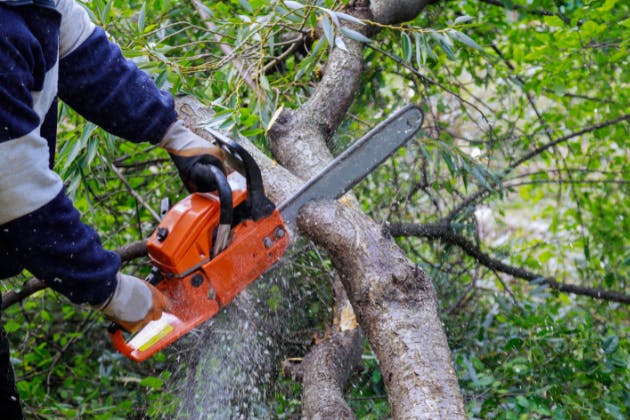Trees are an essential part of our environment, providing numerous benefits from air purification to aesthetic appeal. However, there are times when cutting down a tree becomes necessary. This comprehensive guide tackles the critical question: "When to Cut a Tree Down?"
By examining various factors, from safety concerns to legal considerations, we'll equip you with the knowledge to make informed decisions about tree removal. Whether you're a property owner or simply interested in tree maintenance, understanding when and why to remove a tree is crucial for ensuring safety, preserving property value, and maintaining a healthy landscape.
Reasons to Cut a Tree Down
Safety Concerns
Trees can pose significant safety risks when they are dead, diseased, or damaged. Dead branches or entire trees can fall unexpectedly, potentially causing injury or property damage. Trees with branches overhanging power lines are particularly hazardous, as they can cause power outages or fires if they come into contact with the lines. Similarly, trees leaning towards buildings or roads present a clear danger and should be addressed promptly.
It's crucial to regularly assess trees on your property for signs of instability or decay. Look for cracks in the trunk, fungal growth, or large dead branches. If you notice any of these signs, it's time to consider removal.
Aesthetic and Structural Issues
Trees can significantly impact the appearance and functionality of a property. Overgrown trees may block natural light from entering your home, leading to increased energy costs and potentially affecting your mood and health. Large trees can also obstruct access to certain areas of your property or interfere with planned construction or landscaping projects.
Moreover, trees can affect neighbouring properties by casting shadows, dropping leaves, or encroaching on boundary lines. In some cases, this can lead to disputes or legal issues, making removal a necessary step to maintain good relationships with neighbours.
Health of the Tree
Identifying a dying or dead tree is crucial for maintaining the overall health of your landscape. Signs of a dying tree include:
- Sparse foliage or brown leaves during growing season
- Bark that's falling off or has deep cracks
- Fungal growth at the base of the trunk
- Presence of pests like carpenter ants or wood-boring beetles
Dead trees should be removed promptly as they can become breeding grounds for pests and diseases that may spread to healthy trees nearby. They also become increasingly unstable over time, posing a greater risk of falling.
Property Maintenance
Trees can interfere with various aspects of property maintenance. They may:
- Block views from windows or outdoor spaces
- Drop excessive leaves, fruits, or seeds, creating a constant clean-up task
- Interfere with utility lines or underground pipes
- Damage foundations or pavements with their root systems
In these cases, removal might be the most practical long-term solution to reduce ongoing maintenance issues and potential property damage.
Factors to Consider Before Cutting a Tree Down
Tree Species and Age
Different tree species have varying lifespans, growth rates, and susceptibility to diseases. Before deciding to remove a tree, consider its species-specific characteristics. For example, some fast-growing species like poplars may need to be removed sooner due to their tendency to become unstable as they age. Conversely, slow-growing species like oaks can often be safely maintained for many decades with proper care.
The age of the tree is also crucial. Younger trees might be salvageable through pruning or treatment, while older specimens may have reached the end of their natural lifespan and require removal.
Legal and Regulatory Aspects
Before cutting down any tree, it's essential to check for any legal restrictions. Many areas have tree preservation orders (TPOs) in place to protect specific trees or groups of trees. These orders make it illegal to cut down, top, or otherwise alter the tree without permission from the local authority.
Additionally, some trees may host protected species, such as bats or certain birds. Disturbing these habitats without proper authorisation can result in severe penalties. Always consult with your local council or a professional arborist to ensure compliance with all relevant regulations.
Environmental Impact
Trees play a vital role in local ecosystems, providing habitats for wildlife and contributing to air quality. Before removing a tree, consider its environmental impact. Large, mature trees are particularly valuable for their ability to absorb carbon dioxide and provide shade, which can help reduce energy costs.
If removal is necessary, consider planting a replacement tree in a suitable location to maintain the ecological balance of your property.
Speak with tree surgeons in Hertfordshire, St Albans and Harpenden
Simply call us on 07775 743861 and we'll be happy to help.



